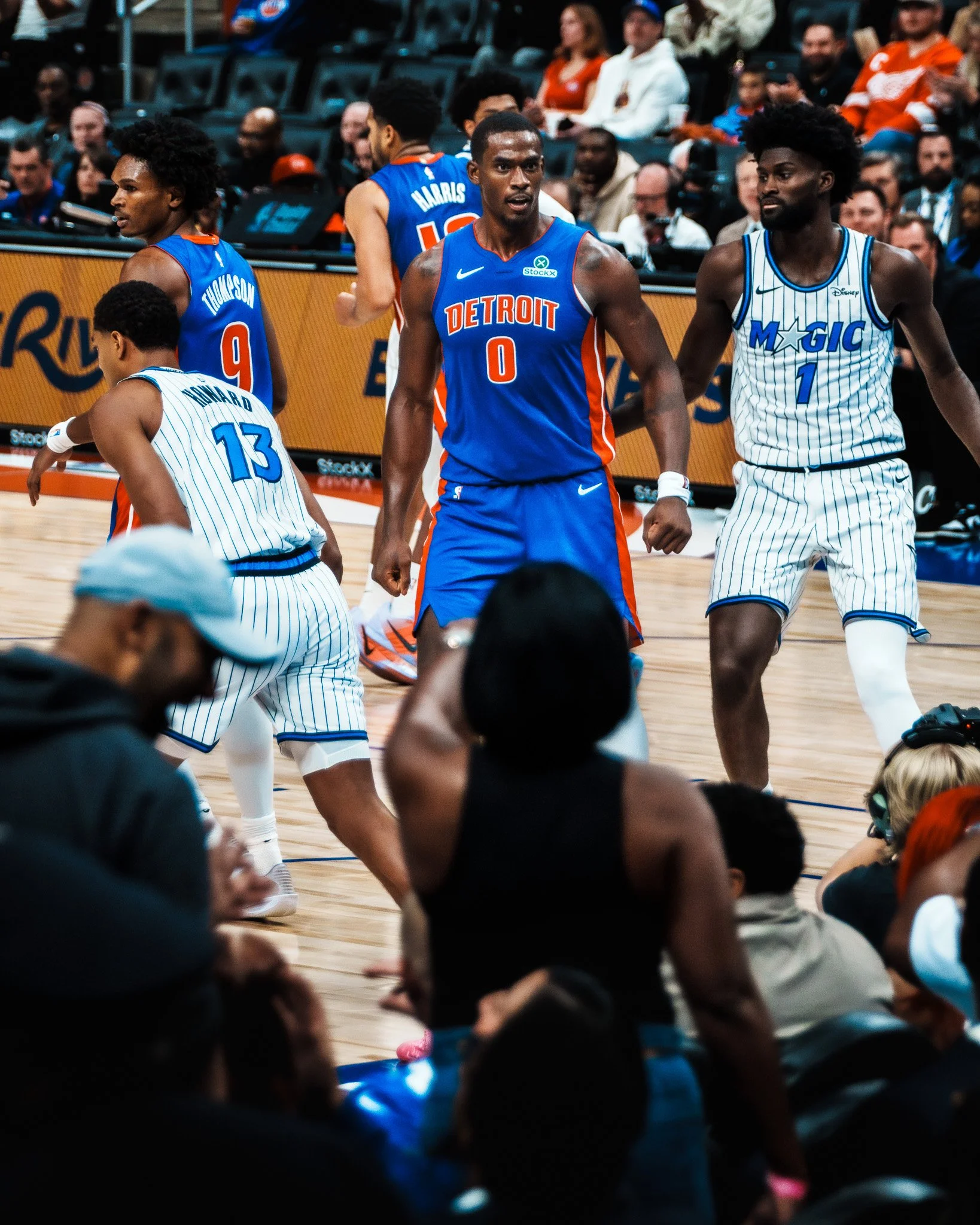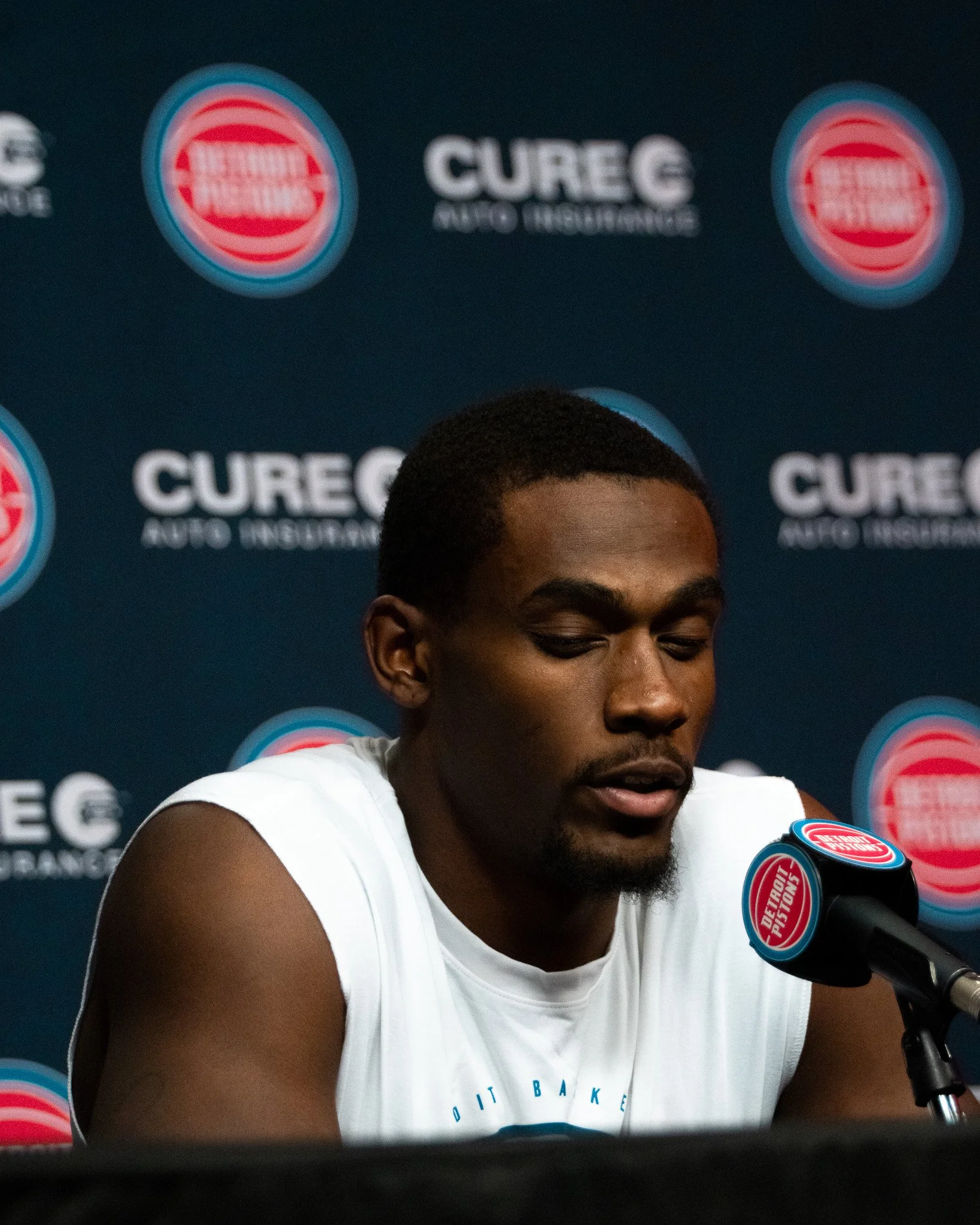Jalen Duren and The Leap
Jalen Duren vs. Orlando, October 29th, 2025—Shot by Zariq Turner for BULLYBALL
I’m not sure there is a more imposing twenty-two-year-old on the planet than Jalen Duren.
Going into the season, there was no more polarizing player on the Pistons roster.
With rookie extension conversations ongoing all summer, plenty of discussion around the fan base was rooted in the same question.
“Is he worth it?”
Drafted with the 13th overall pick in the 2022-2023 NBA Draft, Duren’s physical capabilities were quite obvious from the start.
Listed at 6’10 250lbs with a 7’1 wingspan, Duren’s ability as a screener, lob threat, and rebounder were positives the day he stepped on the floor, freshly 19 years old.
His broad shoulders, strength, and vertical athleticism stood out amongst NBA adults immediately.
The production was always consistent.
Duren averaged almost a double-double in his rookie season and now has the two-plus seasons after.
And yet, questions about his offensive skillset, defense effort, roster alignment, and overall impact arose regarding the young big.
Going through three different coaching staffs in three seasons, an entire organizational overhaul after year two, and constant roster mismanagement, much of his time in Detroit has been plagued by instability.
Despite the aforementioned consistent production, worries of developmental stagnation became part of the dialogue.
Though real improvements were shown towards the end of last season, the sample size wasn’t large enough to inspire confidence to match the assumed contract extension.
Now into his fourth NBA season, it’s time for Duren’s impact to truly be felt and for that extension to be earned.
Playmaking Prowess
Jalen Duren vs. Orlando, October 29th, 2025—Shot by Zariq Turner for BULLYBALL
With his first two seasons filled with nothing but turmoil, Duren was finally able to find some footing last season under Head Coach J.B. Bickerstaff. The results weren’t immediate, but they were definite. Offensively is where those improvements shone brightest.
While his connection with Cade Cunningham has continued to be one of the best in the league, Duren has also managed to evolve his skillset individually. Much of this improvement centers on his playmaking, particularly with Ausar Thompson.
Last season (per databallr.com), Duren ranked in the 81st percentile in potential assists and in the 88th percentile in rim assists per 100 possessions. This was seen ad nauseam over the six-game playoff series versus the Knicks last season.
Cade is inherently a pick-and-roll dominant player, which means he often draws two defenders towards the ball.
With his pull-up mid-range game alongside his renowned playmaking ability, New York turned hard-hedging Cade in pick-and-roll actions to force others to create offense.
Defenders were forced to engage Cade high and “hedge," putting two defenders on Cade and pushing him towards the sidelines.
Even when given advantageous scenarios, the Pistons had to adjust to create favorable looks against this coverage.
Cunningham emphasized getting the ball out early to Duren.
Instead of rolling hard to the rim, Duren catches in the middle of the floor via a quick pocket pass or jump pass over outstretched arms. With two defenders recovering behind the play, this created a four-on-three advantage for the offense.
The weakside shooter lifting from the corner, Ausar cutting towards the dunker spot, and strong-side off-ball movement/screening, the Pistons found a good amount of success in these actions.
The former Memphis Tiger can catch, survey, and make decisions before defenses can react.
In a starting lineup that will presumably feature two non-shooters for the foreseeable future, the connection between Duren and Ausar becomes imperative.
We have also seen glimpses of the opposite scenario, with Ausar as the screener and secondary creator instead.
If the low-man defender steps middle to stop the roll, the lob or dump down pass should be available. If help comes from the sides, shooters should be open.
Though it may seem simple, these are NBA defenses they’re playing against.
Teams have increasingly improved at “helping the help”, making proper rotations, and defensive schemes and gameplans are ever-evolving.
In a league where quick decision-making is becoming a necessity among ancillary players, these reads become a necessity alongside Cade Cunningham’s inherent gravity.
Despite the herculean efforts by the Pistons defensively, their half-court offense eventually slowed to a halt in the playoffs. Season-long turnover issues reared their head again, and shots stopped falling. Game-planning still left plenty to be desired.
While far from perfect, the experience Duren gained in that Knicks series will only help him process the floor better and get to those secondary reads quicker than before.
On-Ball Offense
Jalen Duren and Cade Cunningham vs. Orlando, October 29th, 2025—Shot by Zariq Turner for BULLYBALL
For much of Jalen Duren’s career, he was pigeonholed as a traditional screen & roll big.
This season has been an entirely different story.
Perhaps the most impressive and noticeably improved player in the NBA so far this season, he is averaging a career high 20.5 points per game on 72 TS% and 76.7% from the charity stripe.
While the numbers alone are impressive, the way he has evolved overall offensively is imperative to the Pistons’ early-season success.
Duren’s creation of true shot attempts, which includes isolation, PnR handler, and post-up possessions, has almost doubled from the season prior (per databllr.com).
Per 100 possessions, Duren has gone from 2.0 to 5, putting him in the 82nd percentile of NBA players.
Furthermore, according to NBA.com, JD’s usage rate has increased from 16.1% last season to 23.3% currently.
He also has almost doubled his drives per game from 1.9 to 3.7, respectively.
This increase in self-creation and downhill drives has been substantial in Duren’s overall scoring increase.
While much of his production early in his career came off PnR or offensive rebounding, he has now realized other paths to better point production.
So far this season, Duren has also increased his personal fouls drawn per game from 2.6 to a respectable 5.4 (per NBA.com).
The aforementioned drives are a large reason as to why, and they help place Duren in the 99th percentile of NBA players, drawing 9.2 FTA per 75 possessions (databllr.com).
If Jalen can continue to shoot free throws at a similar clip as of late, the scoring surge feels sustainable.
As the scoring profile continues to expand, his previously mentioned playmaking ability will only continue to grow alongside.
With so much defensive attention often centered around Cade Cunningham, the ability for him to counter and/or ease some offensive responsibility is a plus for the Pistons’ offense.
While it is yet to be seen if this play from Duren is truly sustainable, these developments are essential in regards to the Pistons’ current roster construction.
Defensive Deficiencies
Jalen Duren postgame vs Utah, November 5th, 2025—Shot by Zariq Turner for BULLYBALL
The discussion around Jalen Duren’s defense requires context.
While Duren had his own deficiencies, the Pistons set him up for failure; inconsistent defensive responsibilities, questionable roster construction, and suspect coaching plagued his first years with the team.
Coming into his rookie season, there were plenty of unknowns about the Pistons’ roster.
Coming off a largely successful rookie campaign, Cade Cunningham was the lone star of the group, but he had a season-ending injury only 12 games into the year.
Developmental players such as Killian Hayes, Saddiq Bey, Isaiah Stewart, and (fellow 2022 rookie) Jaden Ivey all had an abundance of unanswered questions about the standing of their NBA careers.
The veterans on the roster consisted of an aging Bojan Bogdanovic, Alec Burks, and Rodney McGruder. The best perimeter defender Duren was able to play with was Killian Hayes.
This is simply not a conducive environment for improvement, especially for an 18-year-old playing the most important defensive position on the basketball court.
Little communication, perimeter resistance, and overall defensive consistency led to easy looks, both for ball handlers and often Duren’s assignment. Bad tendencies, bad habits, and bad technique were the result.
The offense was never much of a concern, but at times, the defense was borderline unplayable.
Year two is when, of course, everything fell apart.
Despite what we all assumed to be roster and coaching improvements, a lack of overall organizational care led to one of the most embarrassing seasons in NBA history.
“We were losers for a little stint in the NBA,” said Cade Cunningham in a post-game interview on November 5th this season.
It can be understandably hard to learn and grow amongst such inadequacy.
Then came the organizational shift.
Into his third NBA season, Jalen Duren finally had a roster and coaching staff surrounding him that was favorable for his development.
The turnaround wasn’t immediate, with the first half of last season filled with plenty of defensive woes and lapses in coverage. Though as the season progressed, it seemed so did Duren’s understanding of his coaches’ expectations.
Now with playoff series experience and another offseason under J.B. Bickerstaff and his coaching staff, expectations only rise higher.
While the sample size is still very small, in the 16 games the Pistons have played so far this season, Duren has posted a 109 defensive rating, putting him as a +1 on/off for the second-best defense in the league at 110 (NBA.com).
Duren has shown significant improvement in guarding in space and switching, in helpside defense, and with tracking the ball for blocks and deflections.
Though there is still much room for improvement, his progress is already noticeable.
Playing alongside now-solidified defenders such as Ausar Thompson and Isaiah Stewart certainly help ease some of the burden and responsibility on that end.
Duren and Stewart form a formidable interior while also being able to switch big-to-big actions on the perimeter, while Ausar stifles any ball-handlers in the vicinity.
While perhaps the defensive counting stats aren’t particularly eye-popping, Duren is an integral piece for the second-rated defense in the association.
Internal growth and development is a difficult bet to rely on; however, it can prove worthwhile over time.
The Duren-and-Cunningham connection is one we will likely see for the next decade plus, with Jalen’s new contract coming this summer.





